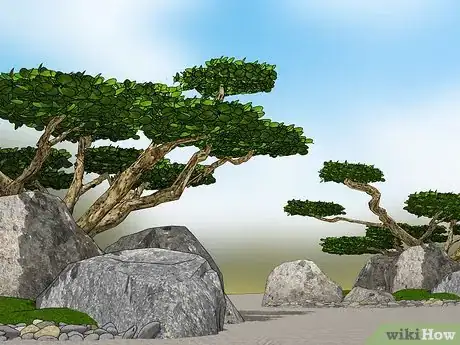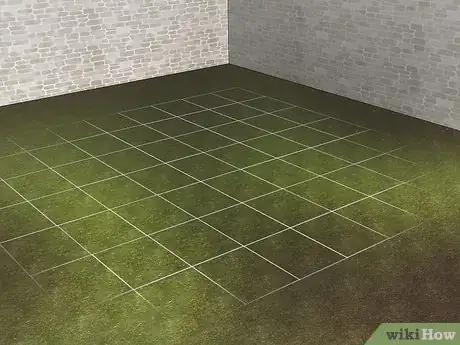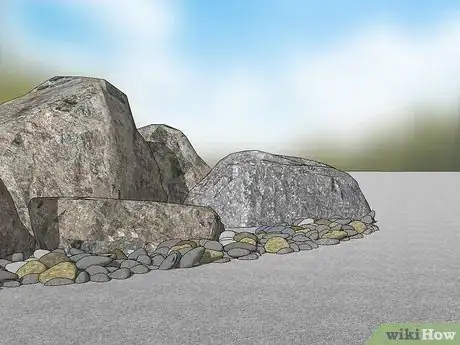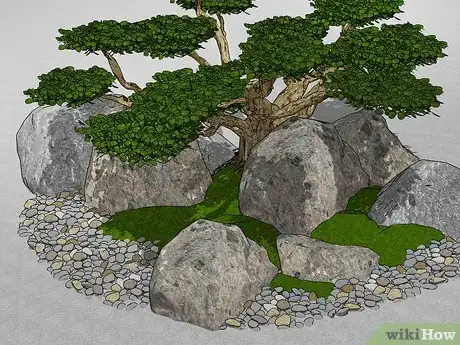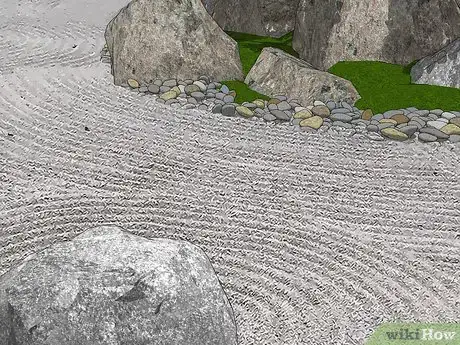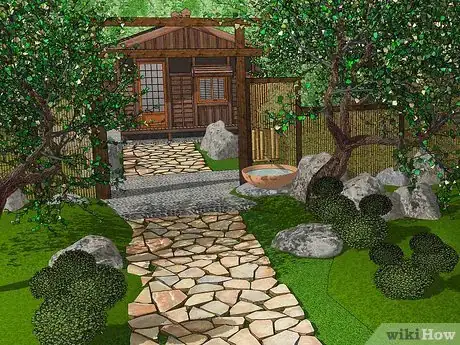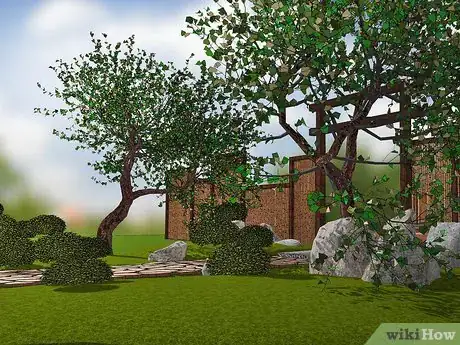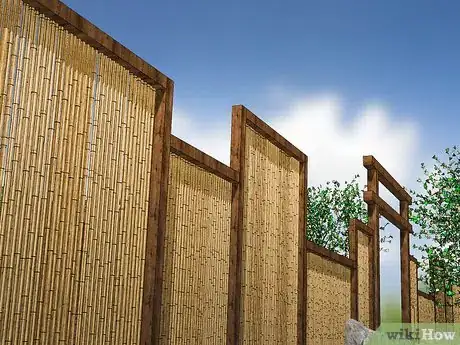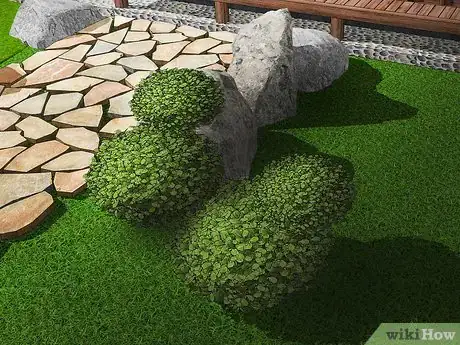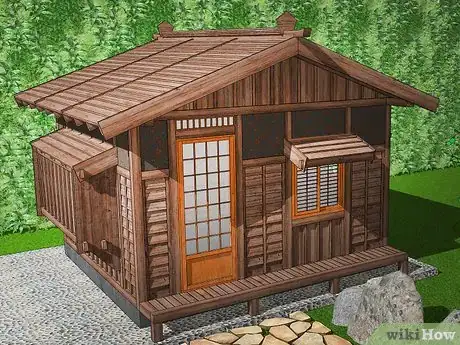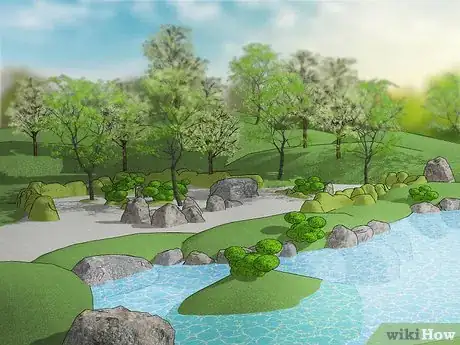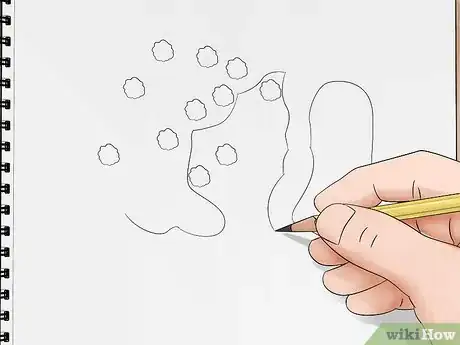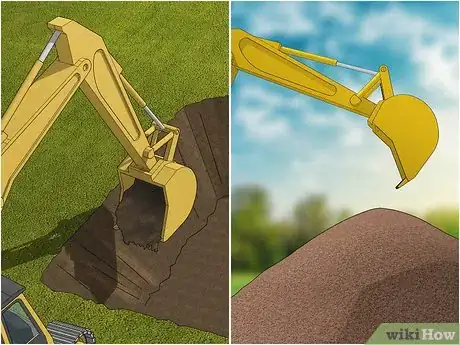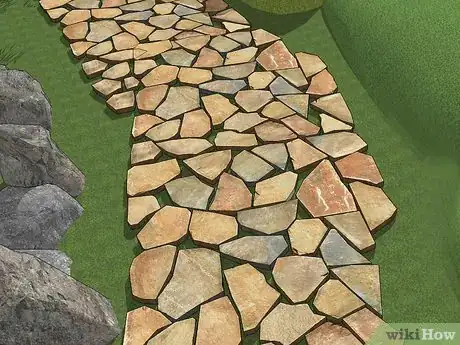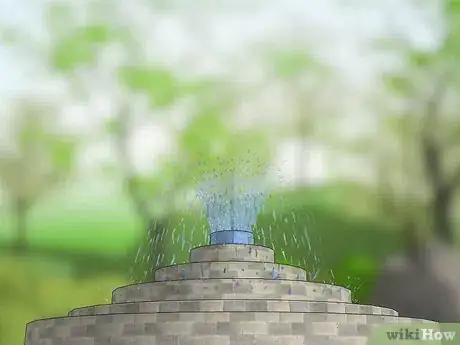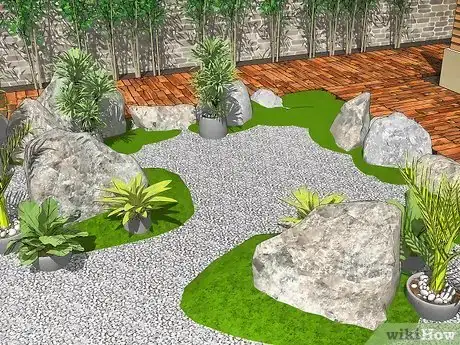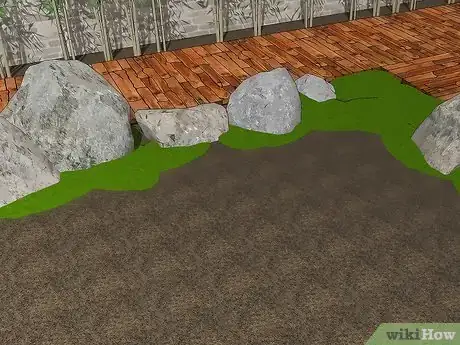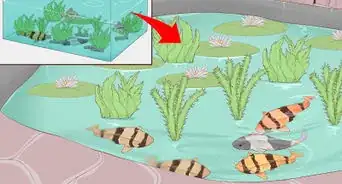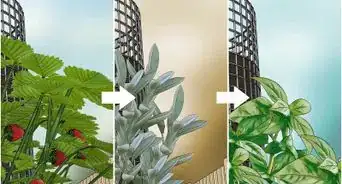This article was co-authored by Lauren Kurtz. Lauren Kurtz is a Naturalist and Horticultural Specialist. Lauren has worked for Aurora, Colorado managing the Water-Wise Garden at Aurora Municipal Center for the Water Conservation Department. She earned a BA in Environmental and Sustainability Studies from Western Michigan University in 2014.
There are 8 references cited in this article, which can be found at the bottom of the page.
This article has been viewed 135,789 times.
Japanese gardens are renowned for their quiet beauty and pristine plant growth. Adding a Japanese garden to your home is a great way to build your own little getaway, all while putting your green thumb to use. There are several types of Japanese gardens, so do a bit of research to figure out which type of garden you'd like to build.
Steps
Building a Zen Garden
-
1Build a Zen garden if you want a completely dry garden. Zen gardens, also known as Japanese rock gardens, are designed to be dry. They are typically comprised of different sized boulders, gravel, sand, and rocks. Boulders and rocks represent islands and the sand and gravel are meant to represent water, which is why wave designs are typically drawn in the sand and gravel.
-
2Choose a flat piece of land to build your garden on. Zen gardens are typically made on flat and leveled landscapes, so it's important that you choose the flattest possible piece of land. You may need to level the land yourself with a bit of digging and dirt packing. These gardens are typically made in the shape of a square.
- Zen gardens can vary in size, so how big you make it is completely up to you. Zen gardens are often used for meditation, so make the garden big enough for you to meditate in.
- Since Zen gardens are dry gardens, you should remove existing grass or flowers from the area in which you are building your garden. Natural moss, small trees, and shrubbery are the types of plants typically found in Zen gardens. If you have these types of plants, do not remove them.
- If you need to level your own land, use a carpenter's level to make sure that you've made your ground as even as possible.[1]
Advertisement -
3Add rocks, boulders, and sand to your garden. Start by creating a border around your Zen garden with rocks and boulders. This will help keep your gravel and sand inside of your designated Zen garden, and stop it from spreading all over the rest of your yard. After you've lined your Zen garden with rocks, spread a layer of gravel or sand over the bottom of your garden (it should be 3-4 inches thick). Then, place different sized rocks and boulders throughout the rest of the garden.[2]
- Rocks are typically placed in small groupings throughout the garden, as this creates a simple and polished look. Your rocks and boulders should vary in size from very large to small.
-
4Incorporate the proper plants into your garden. Zen gardens are simplistic and typically include limited plant life – mostly moss, small trees, and shrubbery. Besides this limited addition of plants, the main focus of Zen gardens is the raked gravel symbolizing streaming water. Don't add too many elements, as Zen gardens are meant to be simple and relaxing.[3]
- If you do not have natural trees or moss in the area of your Zen garden, add a few small potted plants to the garden. Small shrubs and bamboo plants make for good additions to your Zen garden.
-
5Rake water designs into your Zen garden. It is important to rake your gravel or sand so that it replicates flowing water, as this is a key element to a proper Zen garden. You can use a regular garden rake to pull designs through your sand or gravel. It's best to use a rake that has larger, wider set teeth, as this will create a better, more legible design.
- Use a broom, or a broom handle, to perfect the grooves created by the rake. Once the grooves are created with a rake, use a broom or broom handle to press down into the grooves. This will make the grooves deeper and easier to see. The bristle end of a broom is typically thicker and makes wider, softer indentations than the handle of a broom would. The handle end of a broom is normally thinner and is easier to use when making smaller, tighter designs.
- The water designs are meant to be calming and relaxing, so creating them should also be a relaxed process. Slowly and carefully pull your rake through the gravel to create beautiful designs.
- You can create circular designs, straight designs, or flowing designs. This is your garden, so create whichever designs are the most beautiful to you.
- Raking should be a part of the regular maintenance of the garden, done as a form of meditation rather than a chore. Touch up your water designs every week.
Creating a Tea Garden
-
1Build a tea garden. Traditional Japanese tea gardens are divided into two areas that are separated by a simple barrier, such as a small gate or a wall of rocks. This barrier should also have an opening to walk through. The outer garden is meant to be a pathway into the tea ceremony, and the inner garden is where the tea ceremony takes place. Often, the inner garden contains a tea house. The purpose of a tea garden is to get into a peaceful state of mind before beginning a tea ceremony.[4]
- The inner garden is the main focus of a tea garden, as this is where the tea ceremony takes place. The outer garden can be as large or small as you'd like it to be. It should, at the very least, be a walkway into the tea house.
- These gardens can be on flat or hilly pieces of land. However, you should create a flat surface to build your tea house on.
-
2Create the outer garden. The outer garden of a tea garden serves as a pathway to the inner garden. Outer gardens generally include a pathway to the inner garden, a few simple shrubs and plants, and some type of water element (such as a waterfall, small pond, or fountain). Traditionally, tea gardens were kept deliberately natural and woodsy to provide a calming transition between the outer world to a tranquil tea ceremony.
- The pathways are typically made out of flat stones or wooden planks. This pathway can be as long or short as your space allows, and can be set up in a straight or winding path.
- Plants in the outer garden should be informal. Do not include bright plants or flowers. Instead, stick to mosses, shrubs, and trees that would be found in nature.
- Include a few lanterns to light the pathway for nighttime tea ceremonies.[5]
-
3Include a cleansing area between the two gardens. Ritual cleansing is important in a tea garden, as it purifies a person before they begin their tea ceremony. A stone water basin (a tsukubai) should be placed in an area between the outer and inner gardens where visitors can wash their mouth and hands. These basins are typically built low to the ground so that visitors must crouch or kneel to cleanse themselves. Crouching or kneeling is also viewed as a sign of respect.
- The cleansing area should be right before one enters into the inner garden. You must cleanse yourself before entering the inner garden.[6]
-
4Create a wall or gate to separate the outer and inner gardens. A small gate or wall of rocks is usually built to separate the outer garden from the inner garden. The wall represents official entry into the tea garden, a place of relaxation and peace from the outside world. You can purchase a small wooden or metal gate to install, or you can make a small wall out of rocks and boulders.
- Build a simple fence out of bamboo. Insert bamboo poles into the ground, and pack dirt or cement around the base of each one to hold it in place. Once you have your posts in place, attach bamboo support poles between each post.
-
5Plant the inner garden. Tea gardens are meant to be simple and serene, so only use natural plants and materials to build the inner garden.The plants used in inner gardens should be ferns, mosses and shrubs. It's acceptable to place one flowering plant inside the actual teahouse.[7]
-
6Build a tea house for your tea ceremonies. The inner garden's focal point should be a tea house. Your tea house doesn't have to be a completely built house; it can simply be a wooden structure with beams and some type of roof. Use natural woods to build your tea house so that it flows with nature. Your tea house should include a sitting area with a low table for you and your visitors to enjoy your tea.
- If you'd like, you can place pillows or cushions on the ground of your teahouse for you and your guests to sit on.
Choosing to Build a Strolling Garden
-
1Create a strolling garden if you want a larger, more luxurious garden. During the Edo Period, the wealthier class of Japan enjoyed a great deal of extravagance and recreation. Strolling gardens with ponds, islands and hills were built on large pieces of land. These gardens usually included a circular trail that allowed people to enjoy the garden from many different perspectives. Many strolling gardens served as extravagant entrances (or the outer gardens) of tea gardens.[8]
-
2Build your strolling garden in the proper area. Strolling gardens require more space than other types of Japanese gardens, making them the least practical type of Japanese garden for most people. However, if you happen to have a huge backyard or a giant piece of land, a strolling garden may be perfect for you. These gardens usually feature a large variety of features – from ponds and rivers to pathways and hills (sometimes artificial hills) – which also makes them one of the most expensive types of Japanese gardens to build.
-
3Plan your garden. Many strolling gardens rely on artificial landscape to make them extremely beautiful and surreal. You should create a pond or river if your property doesn't already have one, as these gardens always have some type of water element. You should also add some hills to your strolling garden if your property is naturally flat. You'll also need to plan a strolling path for your garden. This will help your garden to look like a traditional Japanese strolling garden.
- Plan your garden on paper before actually creating it. This will help you map out all of the work that needs to be done, and help you determine whether or not you need to hire contractors to help you.
-
4Create your landscape. If you plan on adding artificial landscapes, such as small bodies of water or hills, you may need to hire professionals to help you. Artificial hills are usually created by adding mounds of packed dirt to your land, and planting grass on top of these mounds. The goal is to make these new hills a natural part of your existing landscape. Creating a river or pond may be a bit more challenging, as you'll need to dig out chunks of land and transform them into bodies of water. These are big landscaping tasks, and getting professional help is recommended.[9]
-
5Make your strolling path. After you've built your hills and water elements, you should build a strolling path into your garden. You can use gravel, pebbles, wooden planks, or large stepping stones to make your walkway. Your path should flow nicely through your garden.
-
6Add decorative elements to your strolling garden. Whereas the other types of Japanese gardens are usually more natural, strolling gardens can be a bit more extravagant. Decorate your garden with benches, large statues or sculptures, incorporate bright, flowering plants, line your pathway with beautiful lanterns, add a few fountains throughout your garden, etc.[10]
Building a Courtyard Garden
-
1Choose a courtyard garden if you're looking to build a small a garden. Courtyard gardens typically incorporate simple non-flowering plants, a dry stream (made with sand or gravel), and small water elements (such as a fountain). They are usually easy to make and easy to maintain. These gardens are typically meant to be viewed, but not entered.[11]
-
2Pick the right location for your garden. Despite their name, you don't need an actual courtyard to create a courtyard garden. Traditional courtyard gardens are designed for smaller, confined spaces, which makes areas like rooftops, porches, or terraces perfect for them. It's also recommended to incorporate plants that don't require much sunlight, as this will give you more options when choosing a location for your garden.
-
3Create a border for your garden. Using a combination of rocks and plants, create a border for your courtyard garden. This will help you and your visitors distinguish where your garden begins. Once you've created the border for your garden, you can begin decorating it with sand, additional rocks and plants, as well as a simple tree or fountain.
-
4Add the proper elements to your garden. It's easiest to use potted plants in courtyard gardens, as this will allow you to build your garden almost anywhere. Choose plants that require little to no sunlight, such as ferns and palm plants. Pour sand or gravel onto the ground of your courtyard garden, and create a dry stream by raking a water design into it. Incorporate a few rocks, a small tree, or a fountain for additional scenery.
Expert Q&A
Did you know you can get expert answers for this article?
Unlock expert answers by supporting wikiHow
-
QuestionWhat plants would you use for a Japanese garden?
 Lauren KurtzLauren Kurtz is a Naturalist and Horticultural Specialist. Lauren has worked for Aurora, Colorado managing the Water-Wise Garden at Aurora Municipal Center for the Water Conservation Department. She earned a BA in Environmental and Sustainability Studies from Western Michigan University in 2014.
Lauren KurtzLauren Kurtz is a Naturalist and Horticultural Specialist. Lauren has worked for Aurora, Colorado managing the Water-Wise Garden at Aurora Municipal Center for the Water Conservation Department. She earned a BA in Environmental and Sustainability Studies from Western Michigan University in 2014.
Professional Gardener
References
- ↑ http://homeguides.sfgate.com/build-outside-zen-garden-46644.html
- ↑ http://homeguides.sfgate.com/build-outside-zen-garden-46644.html
- ↑ https://dengarden.com/gardening/Everything-You-Need-for-a-Zen-Garden
- ↑ https://www.gardeningknowhow.com/special/spaces/japanese-flower-gardens-plants-for-a-japanese-garden.htm
- ↑ https://www.doityourself.com/stry/japaneseteagarden#b
- ↑ https://www.doityourself.com/stry/japaneseteagarden#b
- ↑ https://www.doityourself.com/stry/japaneseteagarden#b
- ↑ http://buffaloah.com/a/virtual/jap/garden.html
- ↑ https://www.gardeningknowhow.com/special/spaces/japanese-flower-gardens-plants-for-a-japanese-garden.htm
About This Article
Building a Japanese garden can be a great way to create a space to relax in your yard. If you want to create a zen garden, you’ll need to flatten out a square piece of land and surround the area with rocks. Then, cover the square with sand and gravel. You can add a few simple plants, like moss and small trees. Rake through your sand or gravel surface to create grooves that look like water, which creates a relaxing feel. Alternatively, try building a tea garden, which is used for performing tea ceremonies. Tea gardens are divided by a wall of rocks or a small gate into 2 areas, known as the inner and outer garden. The outer area of your garden should have a pathway to your inner garden, and contain a few shrubs and plants. You should also place a water basin between the 2 gardens, which visitors use to cleanse themselves before entering the inner garden. In your inner garden, you’ll want to build a tea house and have natural plants, such as ferns, mosses, and shrubs. For tips from our Gardening co-author on how to create a courtyard garden, read on!
